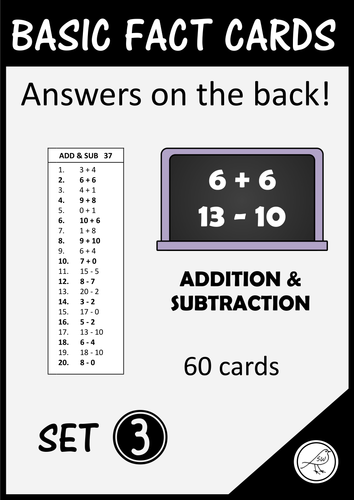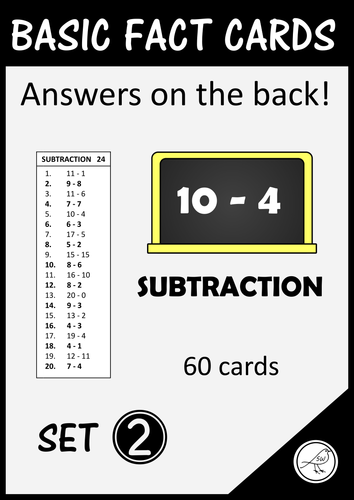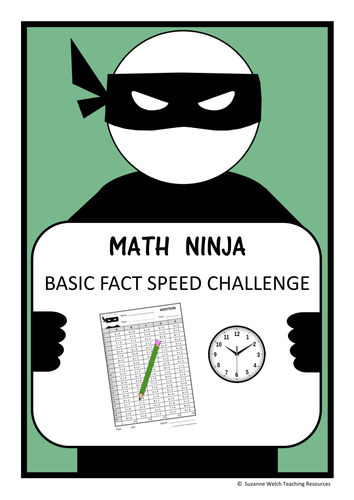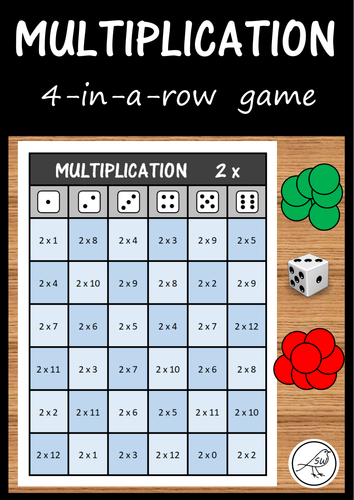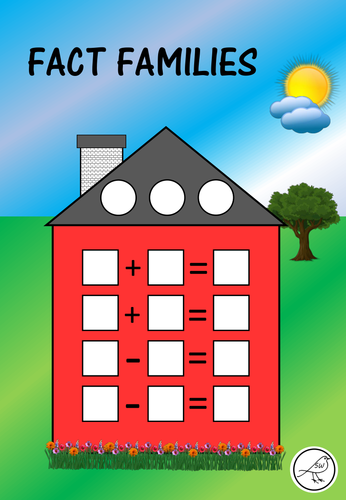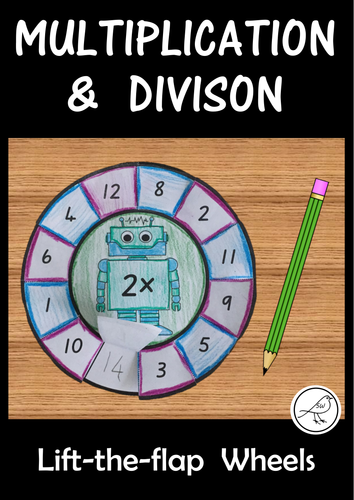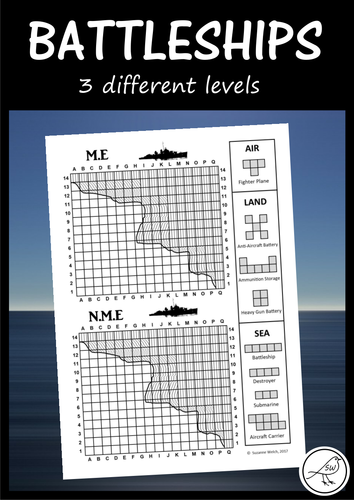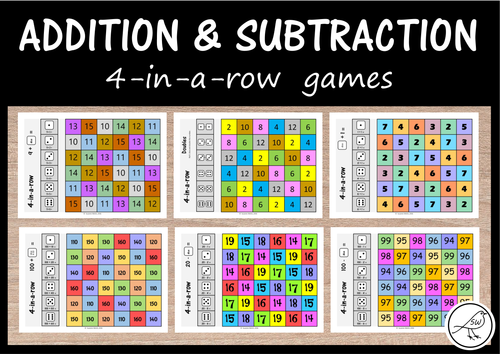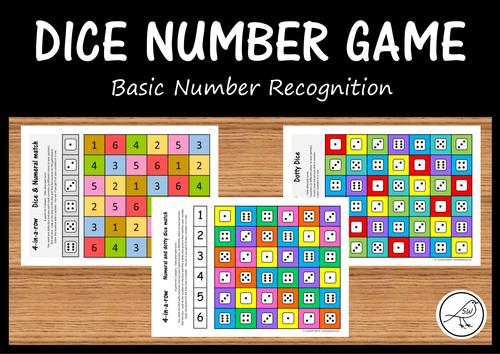
377Uploads
162k+Views
10k+Downloads
Math for early childhood

Math Basic Fact Cards – Set 3 – Addition and Subtraction
60 basic fact cards with a mixture of addition and subtraction questions.
Addition questions use numerals 0-10 and subtraction questions use numerals 0-20.
20 questions per card (10 addition questions followed by 10 subtraction questions).
Answers are on the back of the card (great for self-marking)
Each card has the same level of difficulty.
Every second question is in bold font.
All questions/answers are numbered 1-20.
Examples of questions:
8+2
7+7
16-10
11-4
Ideas for using these cards in your classroom:
♦ daily practise.
♦ warm up math activity.
♦ math rotation activity.
♦ independent math centre activity.
♦ early finisher activity.
♦ math challenge activity (eg complete 3 cards in 3 minutes with 100% accuracy)
What you need to do:
Print, cut, fold and laminate the cards. (They need to be folded so the question is on the front and the answer is on the back). If you purchase additional sets (see below) then I suggest you print them onto coloured paper to differentiate them.
Made on A4 size paper.
4 cards per sheet.
Each card is approximately 45mm by 135mm.
The font is Calibri size 14.
10 different sets of basic fact cards are available in my store:
SET 1 – addition
SET 2 – subtraction
SET 3 – addition and subtraction
SET 4 – addition and subtraction with a missing number or sign (eg 4+=9 or 31=4)
SET 5 – multiplication (0x0 to 12x12)
SET 6 – division
SET 7 – multiplication and division
SET 8 – addition, subtraction, multiplication and division
SET 9 – add/sub/mult/div with a missing number or sign (eg. x4=36 or 279=3)
SET 10 – add/sub/mult/div with brackets eg. (3+4) x (12-2)
Please note that these sets of basic fact cards are also part of my 'BASIC FACT BLACK BELT CHALLENGE.
© Suzanne Welch Teaching Resources

Math Basic Fact Cards – Set 2 - Subtraction
60 basic fact cards with subtraction questions (using numerals up to 20)
20 questions per card.
Answers are on the back of the card (great for self-marking)
Each card has the same level of difficulty.
Every second question is in bold font.
All questions/answers are numbered 1-20.
Examples of questions:
5-5
17-4
10-6
9-7
Ideas for using these cards in your classroom:
♦ daily practise.
♦ warm up math activity.
♦ math rotation activity.
♦ independent math centre activity.
♦ early finisher activity.
♦ math challenge activity (eg complete 3 cards in 3 minutes with 100% accuracy)
What you need to do:
Print, cut, fold and laminate the cards. (They need to be folded so the question is on the front and the answer is on the back). If you purchase additional sets (see below) then I suggest you print them onto coloured paper to differentiate them.
Made on A4 size paper.
4 cards per sheet.
Each card is approximately 45mm by 135mm.
The font is Calibri size 14.
10 different sets of basic fact cards are available in my store:
SET 1 – addition
SET 2 – subtraction
SET 3 – addition and subtraction
SET 4 – addition and subtraction with a missing number or sign (eg 4+=9 or 31=4)
SET 5 – multiplication (0x0 to 12x12)
SET 6 – division
SET 7 – multiplication and division
SET 8 – addition, subtraction, multiplication and division
SET 9 – add/sub/mult/div with a missing number or sign (eg. x4=36 or 279=3)
SET 10 – add/sub/mult/div with brackets eg. (3+4) x (12-2)
Please note that these sets of basic fact cards are also part of my 'BASIC FACT BLACK BELT CHALLENGE.
© Suzanne Welch Teaching Resources

Math Basic Fact Cards – Set 1 - Addition
60 basic fact cards with addition questions (using numerals 0 to 10)
20 questions per card.
Answers are on the back of the card (great for self-marking)
Each card has the same level of difficulty.
Every second question is in bold font.
All questions/answers are numbered 1-20.
Examples of questions:
4+2
6+7
0+9
8+8
Ideas for using these cards in your classroom:
♦ daily practise.
♦ warm up math activity.
♦ math rotation activity.
♦ independent math centre activity.
♦ early finisher activity.
♦ math challenge activity (eg complete 3 cards in 3 minutes with 100% accuracy)
What you need to do:
Print, cut, fold and laminate the cards. (They need to be folded so the question is on the front and the answer is on the back). If you purchase additional sets (see below) then I suggest you print them onto coloured paper to differentiate them.
Made on A4 size paper.
4 cards per sheet.
Each card is approximately 45mm by 135mm.
The font is Calibri size 14.
10 different sets of basic fact cards are available in my store:
SET 1 – addition
SET 2 – subtraction
SET 3 – addition and subtraction
SET 4 – addition and subtraction with a missing number or sign (eg 4+=9 or 31=4)
SET 5 – multiplication (0x0 to 12x12)
SET 6 – division
SET 7 – multiplication and division
SET 8 – addition, subtraction, multiplication and division
SET 9 – add/sub/mult/div with a missing number or sign (eg. x4=36 or 279=3)
SET 10 – add/sub/mult/div with brackets eg. (3+4) x (12-2)
Please note that these sets of basic fact cards are also part of my 'BASIC FACT BLACK BELT CHALLENGE.
© Suzanne Welch Teaching Resources

Number cards 0 to 20 – New Zealand handwriting font
Number cards that can be used for handwriting/maths integration.
Laminate the cards. Your students can then ‘write and wipe’.
The font used is ‘NZ Basic Script’. The letter/number shapes are the same as those recommended in the NZ Ministry of Education Handbook – ‘Teaching Handwriting’.
3 Different Sets of Cards:
♦ 0-20 with empty tens frames (for students to record the number)
♦ 0-20 with counters in tens frames (for students to colour)
♦ 0-20 with empty box (you choose what to draw/write here)
Examples of what your students might draw/write in the empty box:
• Write the number (eg write 7 seven times)
• Write the word (eg ‘seven’)
• Draw a picture (eg draw 7 apples on a tree)
• Write a math fact using the number (eg 5+2=7)
2 cards on each A4 sheet of paper.
© Suzanne Welch Teaching Resources

Math Basic Facts – BLACK BELT CHALLENGE
A basic fact challenge – can your students pass all 10 levels to achieve their ‘Black Belt’ in basic facts?
Students are given a time frame to finish a certain amount of questions with 100% accuracy in order to pass a level (time frame and quantity of questions to be decided by each teacher).
Each card has the answers on the back so students mark their own work … no extra work for you!
Level 1 – White Belt – addition (numerals 0-10)
Level 2 – Yellow Belt – subtraction (numerals 0-20)
Level 3 - Orange Belt – addition and subtraction
Level 4 – Green Belt – addition and subtraction with a missing number or sign
Level 5 – Blue Belt – multiplication (0x0 to 12x12)
Level 6 – Purple Belt – division
Level 7 – Pink Belt – multiplication and division
Level 8 – Red Belt – addition, subtraction, multiplication and division
Level 9 – Brown Belt - addition, subtraction, multiplication and division with a missing number or sign
Level 10 – Black Belt – addition, subtraction, multiplication and division with brackets
Included:
♦ 60 different cards for each level (total of 600 cards – just print what you need).
♦ Student recording sheet (use this or just write the answers in a math exercise book).
♦ Certificates – provided in both colour and black/white.
♦ Student celebration sheet (colour the belt as you achieve).
♦ Class tracking sheet.
♦ Teacher notes.
♦ Blank templates to adjust the order of the levels (if desired) – student celebration sheet and class tracking sheet.
♦ Supplementary sheets for US classrooms (the word ‘colour’ changed to ‘color’).
What you need to do:
Print, cut, fold and laminate the cards. (They need to be folded so the question is on the front and the answer is on the back). Admittedly this takes a bit of setting up, but sit yourself in front of the TV with the laminator and time will go quickly! You will find this resource extremely useful because it caters to such a wide range of ability levels and the cards can be used in many different ways (not just for this black belt challenge).
♦ 10 levels.
♦ 60 cards per level.
♦ 20 questions per card.
♦ Answers are on the back of the card (great for self-marking).
♦ Questions and answers are all numbered 1-20.
♦ All of the cards in each level have the same degree of difficulty.
♦ Size 14 Calibri font is used. Alternate questions are in bold font.
♦ Each card is approximately 45mm by 135mm in size (once folded).
♦ 4 cards per A4 sheet of paper.
Please note that the cards used in this resource can also be purchased in separate sets which are not part of the ‘Black Belt Challenge’. The cards are identical but they are all black/white. They are available in my store ... Math Basic Fact Cards Set 1-10
© Suzanne Welch Teaching Resources

Repeating Patterns – cards, strips and activities.
The ultimate resource to help you teach REPEATING COLOUR PATTERNS.
10 Different Pattern Sequences:
AB
ABC
AAB
ABB
ABCD
AABC
ABCC
AAAB
AABB
ABBC
Included:
♦ 10 pattern cards – provided in 4 different formats.
♦ 30 pattern strips – copy the pattern.
♦ 30 pattern strips – continue the pattern.
♦ 30 pattern strips – identify the missing cube(s).
♦ 24 Clip and flip cards.
♦ 24 Pattern hunt cards.
♦ 6 Worksheets.
♦ 4 Blank templates.
All of the patterns are shown with linking cubes (unifix, unlink, connecting cubes). The only colours you need for copying the pattern, continuing the pattern, and identifying the missing cube(s) are: red, blue, green, yellow. If you don’t have cubes you can use an alternative such as coloured counters, counting bears, etc.

Alphabet and Number Flies
A set of alphabet (a-z) and number (0-100) flies for your classroom. Use them in any way you wish.
Suggestions for use include:
♦ Play ‘Swat the fly!’ - Put the flies on the floor, on a pin board, or hang them. Say a letter/number. Your students find the fly and swat it. (You will need to provide the fly swatter). This is great for letter/number recognition.
♦ Match the lower case letter with the capital letter.
♦ Put the flies in order.
♦ Find all of the odd/even flies, multiples of 3, numerals that add to 10, etc.
♦ Group all of the same colour flies together (colour recognition).
♦ Make a word using the alphabet flies.
♦ Make a math sum using the number flies (eg 5+2=7)
Included:
♦ Lower case letters– coloured
♦ Lower case letters – black/white
♦ Capital letters – coloured
♦ Capital letters – black/white
♦ Numbers 0-100 – coloured
♦ Numbers 0-100 – black/white
9 flies on each A4 size page.
Dotted cutting lines between the flies.
The alphabet flies are a solid colour. There are 9 different colours.
The number flies have a white stripe where the number is placed. The flies are coloured in groups of 10 (eg 0-9, 10-19, 20-29, 30-39 … 100)
The font used is ‘NZ Basic Script’. The letter/number shapes are the same as those recommended in the NZ Ministry of Education Handbook – ‘Teaching Handwriting’.
**********************************************************************
© Suzanne Welch Teaching Resources

Math - Ten Frame Train
A ten frame train that is suitable for using in your math lessons or having as a display on your classroom wall.
Included:
♦ Train engine
♦ Carriages - ten frames 0-10
♦ Carriages - ten frames 0-10 with numeral written at the top
1 engine/carriage per page.
**********************************************************************
© Suzanne Welch Teaching Resources

Strategy Board Games for Critical Thinking
This is a set of 10 board games that work on STRATEGY rather than CHANCE.
The only equipment you need is counters/markers.
Provided in both colour and black/white.
Easy-to-follow instructions are written on the game boards.
All games are for 2 players.
These games develop skills such as:
♦ strategic thinking
♦ logical thinking
♦ spatial perception
♦ planning ahead
♦ social interaction (not played on a screen!)
Games:
♦ Spiralin’
♦ Slide it!
♦ Sandwich
♦ Choices
♦ Pretwa
♦ Block
♦ Len Choa
♦ Nine Holes
♦ Tapatan
♦ Nine Field Kono
Designed on A4 size paper.
**********************************************************************
© Suzanne Welch Teaching Resources

Math Basic Facts - 'Math Ninja' Challenge
A basic fact speed and accuracy challenge.
5 different levels. 100 questions per level. Complete it in the time allocation with 100% accuracy to pass the level.
Five Levels:
1) Addition – using single digit numbers
2) Subtraction – facts to 20
3) Multiplication – 0x0 to 12x12
4) Division – same facts as multiplication
5) Mixture – mixture of levels 1 – 4
Suggested Use:
Students are given a certain allocation of time to achieve the completion of 100 facts with 100% accuracy. If they do this, they pass that level and move on to the next level. I would operate this challenge once a week, but it’s up to you. You select the time, depending on the ability of your students. Answer sheets are provided for self or buddy marking. Hand out certificates to recognise achievement.
Included:
♦ Question sheets (one for each level)
♦ Answer sheets
♦ Student recording sheets
♦ Teacher tracking sheet
♦ Certificates (colour and black/white)
♦ Wall display templates
**********************************************************************
© Suzanne Welch Teaching Resources

Multiplication Game - 4 in a row
A great game to reinforce multiplication facts (x1 to x12)
A game for 2 players.
Equipment needed: one dice, counters.
How to play:
Players take alternate turns. Player A rolls one dice and looks down the column that is the same number as the dice. He/She selects a question and answers it out loud. Player B checks that the answer is correct. Player A places a counter on that square. The first player to get 4 counters in a row is the winner. The row may be horizontal, vertical or diagonal.
The instructions are written at the base of each game board.
Game Boards:
x 1
x 2
x 3
x 4
x 5
x 6
x 7
x 8
x 9
x 10
x 11
x 12
mixture of x2 x5 x10
The facts on each board range from x0 to x12.
Choice of colour:
♦ 2 tone coloured boards
♦ single coloured boards
♦ black and white boards
Made on A4 sized paper.
**********************************************************************
© Suzanne Welch Teaching Resources

Number Identification 1-100 - 'Park the Car' activity
This is a great hands-on activity for students (particularly boys) to practise their number identification to 100. Students ‘drive’ their toy car and park it in the correct space.
Activity examples:
♦ Park your car on number ____.
♦ Park your car on a number that is one more than ____.
♦ Park your car on a number that is one less than ___.
♦ Park your car on a number that is bigger/smaller than ____.
♦ Park your car on an odd/even number.
♦ Park your car on a number that is between ____ and _____.
♦ Park your car on the answer to this question ______ . (eg 5+2)
33 different car park templates are provided.
Types of car parks include:
♦ numbers 0-9
♦ numbers 1-10
♦ numbers 11-20
♦ odd and even numbers 1-20
♦ decade numbers (10-19, 20-29, 30-39, etc)
♦ -teen and -ty numbers (eg 17 and 70)
♦ tens (10, 20, 30, 40, etc)
♦ mixture of numbers between 1-50
♦ mixture of numbers between 50-99
♦ mixture of numbers between 1-99
♦ double digits (eg 22, 33, 44, 55, etc)
♦ words (one – ten and eleven – twenty)
♦ count the dots (1-10)
♦ ten frames (1-10)
♦ tally marks (1-10)
A car park for ‘hundreds’ is also included (100, 200, 300, 400 etc).
* The font used is ‘NZ Basic Script’.
* Car parks are provided in both grey and white (see images in PREVIEW).
* Blank Templates are provided for you to make up your own number car parks.
* You will need to provide your own toy cars, however there are some included that you can print, cut and laminate if necessary.
* More than one car park can be lined up to provide an extra challenge for your students.
**********************************************************************
© Suzanne Welch Teaching Resources

Multiplication Game - 4 in a row (alien theme)
A fun multiplication game that reinforces knowledge of the 1x1 to 9x9 facts.
Included:
♦ 4 game boards (numbers are arranged differently on each board)
♦ Instructions
♦ Multiplication grid (to support lower ability students)
Provided in colour and black/white.
How to Play:
Player A starts by placing a marker under (or on) two of the alien numbers at the bottom of the game board. Player A multiplies these two numbers together and covers that answer on the board with one of their counters. Player B moves one of the markers to a new number. Player B multiplies these two numbers together and covers that answer on the board with one of their counters. Play continues in this way, with players taking alternate turns and moving only one of the markers each time. If a player moves a marker to make a multiplication question where the answer is already covered, they lose their turn. The winner is the player who makes a row of 4 with their counters. The row may be horizontal, diagonal or vertical.
Number of players: 2
Equipment: counters and markers (The markers are used to show which two 'alien' numbers are being multiplied together. You could use counters, paper clips, little sticks, etc.)
**********************************************************************
© Suzanne Welch Teaching Resources

Family of Facts / Fact Families - houses
Resources for teaching family of facts in math lessons.
Included:
♦ Addition/Subtraction – house and worksheet
♦ Multiplication/Division – house and worksheet
♦ Ice-cream craft and worksheet
The Houses:
The houses are provided in colour, grey, and black/white. Laminate the house and then use it as a teaching tool during lessons (write and wipe). Write 3 family numbers in the circles in the roof.
The Worksheets:
Two worksheets are provided. One with four houses and the other with 6 houses. Write 3 family numbers in the circles prior to photocopying.
The Ice-cream:
Create a 4-scoop ice-cream showing a family of facts.
**********************************************************************
© Suzanne Welch Teaching Resources

Multiplication and Division Wheels - lift the flap
Multiplication and Division wheels for the x1 to x12 facts.
A great ‘craftivity’ to help your students learn and practise the instant recall of their multiplication and division facts.
How to make:
♦ colour / decorate
♦ cut out the two wheels and along the dotted lines between the numbers
♦ glue the top and bottom wheels together (in the centre only)
♦ fold back the flaps
♦ write the answers under the flaps
♦ ready to use!
Two formats:
♦ with a robot graphic.
♦ plain so your students can decorate and personalise their own wheel.
Included:
♦ 12 multiplication wheels with a robot graphic.
♦ 12 multiplication wheels without a graphic.
♦ 12 division wheels with a robot graphic.
♦ 12 division wheels without a graphic.
♦ Instruction sheet.
Designed on A4 size paper.
The font used is ‘NZ Basic Script’. The number shapes are the same as those recommended in the NZ Ministry of Education Handbook – ‘Teaching Handwriting’.
**********************************************************************
© Suzanne Welch Teaching Resources

Playdough Number Mats (1-10)
Playdough Number Mats - Numbers 1-10
♦ Your students make a playdough number and place it on the number on the card.
♦ Then they make some objects for the picture (a small picture in the bottom left corner of each card indicates what they need to make and place on the big picture).
Make 1 spider for the web.
Make 2 fish for the fish bowl.
Make 3 cupcakes for the plate.
Make 4 butterflies for the garden
Make 5 buttons for the shirt.
Make 6 sausages for the fry pan.
Make 7 apples for the tree.
Make 8 eggs for the nest.
Make 9 worms for the pile of dirt.
Make 10 candles for the birthday cake.
The font used is ‘NZ Basic Script’. The number shapes are the same as those recommended in the NZ Ministry of Education Handbook – ‘Teaching Handwriting’.
A4 size.
© Suzanne Welch Teaching Resources

Battleships Game - 3 different levels
Battleships Game
3 different levels. 4 different templates within each level.
Great for reinforcing a math lesson on CO-ORDINATES.
Level 1:
11x10 grid.
5 different forces (7 to destroy).
4 different templates.
Level 2:
17x14 grid.
8 different forces.
4 different templates.
Level 3:
24x14 grid.
Determine your own forces.
4 different templates.
Chart provided to show air/land/sea forces.
Instructions included.
Co-ordinates are letter/number (eg B12)
Land, Air and Sea forces.
© Suzanne Welch Teaching Resources

Number of the Day - Cards (circle border)
Number of the Day – Cards
Strengthen your student’s number knowledge with these task cards. 57 different questions that are applied to your number of the day. Simply pick and choose the cards that are appropriate for your learners.
Included:
♦ 57 cards (3 per page)
♦ Template to make additional cards
♦ Teacher notes
♦ Example answers (using number of the day: 538)
♦ Number of the day worksheet
Suggested Use:
♦ a warm up activity for a maths lesson.
♦ a math centre activity.
♦ an early finisher activity.
♦ an activity while waiting for ‘teacher time’.
♦ a lesson with a focus on number knowledge.
This resource is also available in an alternative border (scrappy style), in my store.
© Suzanne Welch Teaching Resources

Addition and Subtraction Math Games
Addition & Subtraction Dice Games for Maths.
4-in-a-row Gameboards
♦ 14 Different Gameboards.
♦ Equipment needed – dice, counters, gameboard
♦ Suitable for 2 players
♦ All games are provided in both colour and black and white.
How to Play:
1. Player A rolls the dice.
2. Player A looks at the dice picture on the left side of the board and works out the required sum.
3. Player A finds the answer to the sum on the gameboard and covers one of those squares with his/her counter.
4. Player B has their turn.
5. Players continue to take turns. The winner is the first player to get 4 of their counters in a row.
The Gameboards:
♦ dice + 1
1+1, 2+1, 3+1, 4+1, 5+1, 6+1
♦ 5 + dice
5+1, 5+2, 5+3, 5+4, 5+5, 5+6
♦ 10 + dice
10+1, 10+2, 10+3, 10+4, 10+5, 10+6
♦ 10 – dice
10-1, 10-2, 10-3, 10-4, 10-5, 10-6
♦ 20 + dice
20+1, 20+2, 20+3, 20+4, 20+5, 20+6
♦ 20 – dice
20-1, 20-2, 20-3, 20-4, 20-5, 20-6
♦ 100 + dice
100+1, 100+2, 100+3, 100+4, 100+5, 100+6
♦ 100 – dice
100-1, 100-2, 100-3, 100-4, 100-5, 100-6
♦ 100 + (dice x 10)
100+10, 100+20, 100+30, 100+40, 100+50, 100+60
♦ 100 – (dice x 10)
100-10, 100-20, 100-30, 100-40, 100-50, 100-60
♦ Doubles
1+1, 2+2, 3+3, 4+4, 5+5, 6+6
♦ 9 + dice
9+1, 9+2, 9+3, 9+4, 9+5, 9+6
♦ 19 + dice
19+1, 19+2, 19+3, 19+4, 19+5, 19+6
♦ 99 + dice
99+1, 99+2, 99+3, 99+4, 99+5, 99+6
© Suzanne Welch Teaching Resources

Dice Number Games - Basic number recognition
Basic Number Recognition - using a dice (1-6)
4-in-a-row Gameboards
♦ Game 1 – recognising dotty patterns on a dice.
♦ Game 2 – matching a dotty dice picture with a numeral.
♦ Game 3 – matching a numeral with a picture of a dotty dice.
Game 1 – Dotty Dice:
A game for 2 players. Take alternate turns. You need one dotty dice and you each need counters (a different colour to your partner). Roll the dice. Find it on the gameboard and cover the picture with a counter. You win if you get 4 of your counters in a row.
Game 2 – Dice and Numeral Match:
A game for 2 players. Take alternate turns. You need one dotty dice and you each need counters (a different colour to your partner). Roll the dice. Look at the dots on the dice and find the numeral on the gameboard. Cover the numeral with a counter. You win if you get 4 of your counters in a row.
Game 3 – Numeral and Dotty Dice Match:
A game for 2 players. Take alternate turns. You need one dice with numerals and you each need counters (a different colour to your partner). Roll the dice. Look at the number on the dice and find a dotty dice picture that matches your number. Cover the picture of the dice with a counter. You win if you get 4 of your counters in a row.
All 3 games are provided in both colour and black and white.

